南开大学临床肿瘤学2019年考博真题试卷
临床医学肿瘤学考试试题与答案
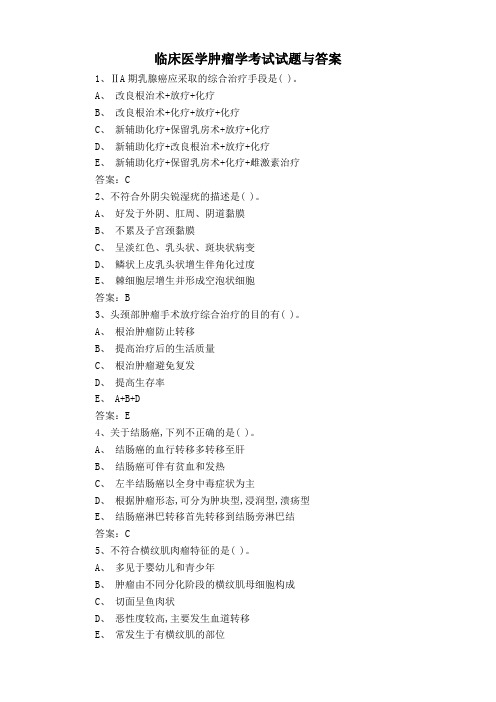
临床医学肿瘤学考试试题与答案1、ⅡA期乳腺癌应采取的综合治疗手段是( )。
A、改良根治术+放疗+化疗B、改良根治术+化疗+放疗+化疗C、新辅助化疗+保留乳房术+放疗+化疗D、新辅助化疗+改良根治术+放疗+化疗E、新辅助化疗+保留乳房术+化疗+雌激素治疗答案:C2、不符合外阴尖锐湿疣的描述是( )。
A、好发于外阴、肛周、阴道黏膜B、不累及子宫颈黏膜C、呈淡红色、乳头状、斑块状病变D、鳞状上皮乳头状增生伴角化过度E、棘细胞层增生并形成空泡状细胞答案:B3、头颈部肿瘤手术放疗综合治疗的目的有( )。
A、根治肿瘤防止转移B、提高治疗后的生活质量C、根治肿瘤避免复发D、提高生存率E、 A+B+D答案:E4、关于结肠癌,下列不正确的是( )。
A、结肠癌的血行转移多转移至肝B、结肠癌可伴有贫血和发热C、左半结肠癌以全身中毒症状为主D、根据肿瘤形态,可分为肿块型,浸润型,溃疡型E、结肠癌淋巴转移首先转移到结肠旁淋巴结答案:C5、不符合横纹肌肉瘤特征的是( )。
A、多见于婴幼儿和青少年B、肿瘤由不同分化阶段的横纹肌母细胞构成C、切面呈鱼肉状D、恶性度较高,主要发生血道转移E、常发生于有横纹肌的部位6、评价CT对腮腺肿瘤诊断,错误的是( )。
A、定位准确B、脂肪瘤可确诊C、囊肿可确诊D、鉴别良恶性有一定限度E、肿瘤内钙化是鉴别良恶性的依据答案:E7、CT平扫时,正常肝内静脉和门静脉的密度是( )。
A、低于肝实质B、高于肝实质C、等于肝实质D、略高于肝实质E、高于或等于肝实质答案:A8、下述关于喉癌的描述不正确的是( )。
A、 90%以上的喉癌可通过间接喉镜发现异常B、喉癌病理类型多为鳞癌C、声门癌颈部淋巴结转移多见且易早期出现D、女性声门上区癌多于男性E、喉癌最常见的远处转移为肺答案:C9、下列那一项不是骨肉瘤的病变特点?( )A、肿瘤质地柔软,无砂粒感B、起源于干骺端,呈偏心性C、 X线上可见Codman三角D、是由前成骨细胞发生的E、可有肿瘤性新生骨答案:A10、患者男性,54岁,出现反复咳嗽咳痰3月,CT图像如下,最有可能的诊断是( )。
临床医学肿瘤学考试题含答案

临床医学肿瘤学考试题含答案一、单选题(共100题,每题1分,共100分)1.化疗药物中抗代谢药物主要作用于( )。
A、Gl期B、G0期C、S期D、M期E、G2期正确答案:C2.下列那一项不是骨肉瘤的病变特点?( )A、肿瘤质地柔软,无砂粒感B、起源于干骺端,呈偏心性C、X线上可见Codman三角D、是由前成骨细胞发生的E、可有肿瘤性新生骨正确答案:A3.乳腺的影像学检查最常用的方法是( )。
A、钼靶软X射线摄影B、干板摄影C、CTD、B超E、乳腺导管造影正确答案:A4.某肿瘤患者(肿瘤α/β值为10Gy),原计划治疗方案70Gy/35次/7周,由于6次发生给量错误为4Gy/次,如果接下来治疗继续用2Gy/次治疗,完成与原计划相当的疗程需要再照射次数约( )。
A、25次B、10次C、20次D、21次E、15次正确答案:D5.营养支持治疗的目的是( )。
A、使患者保持一个良好的营养状况B、更好的耐受抗癌治疗C、尽快恢复体质D、提高生活质量E、以上均正确正确答案:E6.下列关于葡萄胎的描述,不正确的是( )。
A、发生卵巢黄素化囊肿均需手术切除B、是一种良性滋养细胞肿瘤C、可以表现为甲状腺功能亢进征象D、病变局限于子宫腔内,不侵入肌层,也不远处转移E、分为完全性和部分性葡萄胎正确答案:A7.肿瘤发生发展的5个阶段不包括( )。
A、原位癌B、早期浸润癌C、浸润癌D、远处转移E、癌前病变正确答案:B8.患者男性,66岁,反复无痛性肉眼血尿3周,CT图像如下,最有可能的诊断是( )。
CT平扫CT皮质期增强CT髓质期增强CT延时期A、肾盂癌B、肾囊肿C、肾癌D、肾错构瘤E、肾脓肿正确答案:C9.放射性核素显像的作用有( )。
A、显示器官的解剖结构B、显示器官的功能状态C、显示器官的代谢情况D、显示病变组织的解剖结构E、以上都是正确答案:E10.从流行病学的研究性质来分,属于肿瘤流行病学研究方法的包括( )。
A、理论性研究B、描述流行病学研究C、实验流行病学研究D、分析流行病学研究E、以上均是正确答案:E11.不符合异位激素肿瘤的描述是( )。
临床医学肿瘤学试题含答案
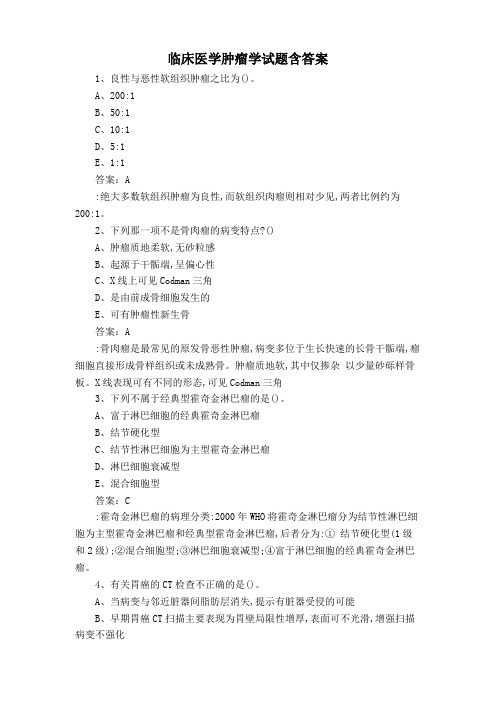
临床医学肿瘤学试题含答案1、良性与恶性软组织肿瘤之比为()。
A、200:1B、50:1C、10:1D、5:1E、1:1答案:A:绝大多数软组织肿瘤为良性,而软组织肉瘤则相对少见,两者比例约为200:1。
2、下列那一项不是骨肉瘤的病变特点?()A、肿瘤质地柔软,无砂粒感B、起源于干骺端,呈偏心性C、X线上可见Codman三角D、是由前成骨细胞发生的E、可有肿瘤性新生骨答案:A:骨肉瘤是最常见的原发骨恶性肿瘤,病变多位于生长快速的长骨干骺端,瘤细胞直接形成骨样组织或未成熟骨。
肿瘤质地软,其中仅掺杂以少量砂砾样骨板。
X线表现可有不同的形态,可见Codman三角3、下列不属于经典型霍奇金淋巴瘤的是()。
A、富于淋巴细胞的经典霍奇金淋巴瘤B、结节硬化型C、结节性淋巴细胞为主型霍奇金淋巴瘤D、淋巴细胞衰减型E、混合细胞型答案:C:霍奇金淋巴瘤的病理分类:2000年WHO将霍奇金淋巴瘤分为结节性淋巴细胞为主型霍奇金淋巴瘤和经典型霍奇金淋巴瘤,后者分为:① 结节硬化型(1级和2级);②混合细胞型;③淋巴细胞衰减型;④富于淋巴细胞的经典霍奇金淋巴瘤。
4、有关胃癌的CT检查不正确的是()。
A、当病变与邻近脏器间脂肪层消失,提示有脏器受侵的可能B、早期胃癌CT扫描主要表现为胃壁局限性增厚,表面可不光滑,增强扫描病变不强化C、当肿瘤浸透浆膜层时,CT表现为浆膜面不光滑,周围脂肪间隙内有点、条状影D、进展期胃癌主要表现为胃壁局限性或弥漫性增厚,可见向腔内或腔外突出的肿块,也可伴有溃疡,增强扫描有不同程度强化E、当病变与邻近脏器间脂肪间隙清晰存在则为脏器无侵犯的可靠表现答案:B:早期胃癌CT扫描主要表现为胃壁局限性增厚,表面可不光滑,增强扫描病变可有强化。
5、在恶性肿瘤患者中,在病程的不同时期需要作放射治疗的大约占()。
A、90%B、30%C、70%D、50%E、100%答案:C:放射治疗是恶性肿瘤治疗的三大手段之一,据统计,约有60%~70%的癌症患者需要接受放疗。
临床医学肿瘤学习题含参考答案

临床医学肿瘤学习题含参考答案一、单选题(共100题,每题1分,共100分)1、为评价梗阻性黄疸,胆管造影的常用方法有( )。
A、ERCPB、PTCC、MRCPD、CDFIE、A+B+C正确答案:E2、下列不符合肿瘤性生长的是( )。
A、常形成肿块B、不需致癌因素持续存在C、细胞分化成熟能力正常D、生长旺盛E、相对无止境生长正确答案:C3、对处于不同周期时相的细胞,对热疗最敏感的细胞期是( )。
A、S期B、各期细胞敏感性相同C、G2期D、G1期E、M期正确答案:A4、下列属于抑癌基因失活主要方式的是( )。
A、以上均是B、基因重排C、点突变D、启动子的甲基化E、基因缺失正确答案:A5、富于淋巴细胞的经典型霍奇金淋巴瘤的RS细胞特点是( )。
A、CD30(+)B、CD20(-)C、CD15(+)D、周围的淋巴细胞为反应T淋巴细胞E、以上都正确正确答案:E6、男性,68岁,右大腿中后部深筋膜浅层可见一肿物,大小6.5×5×4cm,切面灰白灰红色,可见坏死,光镜下瘤细胞异形性明显,形态表现为多形性,可见纤维母细胞、多核巨细胞、组织细胞和炎细胞,以瘤巨细胞最多,部分区域可见车辐状结构。
该患者病理诊断为()。
A、横纹肌肉瘤B、纤维肉瘤C、平滑肌肉瘤D、恶性纤维组织细胞瘤E、恶性神经鞘瘤正确答案:D7、下列属于光镜下区分癌和肉瘤主要依据的是( )。
A、病理性核分裂象的多少B、实质与间质分界是否明显C、细胞膜是否清楚D、细胞异型性的大小E、细胞核大小不一正确答案:B8、以下药物不能改善化疗药物耐药的是( )。
A、维拉帕米B、美司那C、环孢素AD、利血平E、酚噻嗪正确答案:B9、下列有关医患关系的叙述不正确的是( )。
A、医患关系已从传统的道德调整向道德调整和法律规范的过渡B、医患关系的法制化趋势对医生的职业道德提出了越来越高的要求C、随着技术的进步,医患关系在很大程度上被物化了D、医患之间不协调的出现和增加在一定程度上说明了医患关系的民主化趋势E、医患关系的物化必然割裂了医生和患者的情感正确答案:E10、某男性患者,42岁,因腹水行食道钡餐造影检查,发现食管下段黏膜增粗迂曲呈蚯蚓状,管壁有一定的收缩和扩张功能,该病例应诊断( )。
肿瘤学考博试题汇总
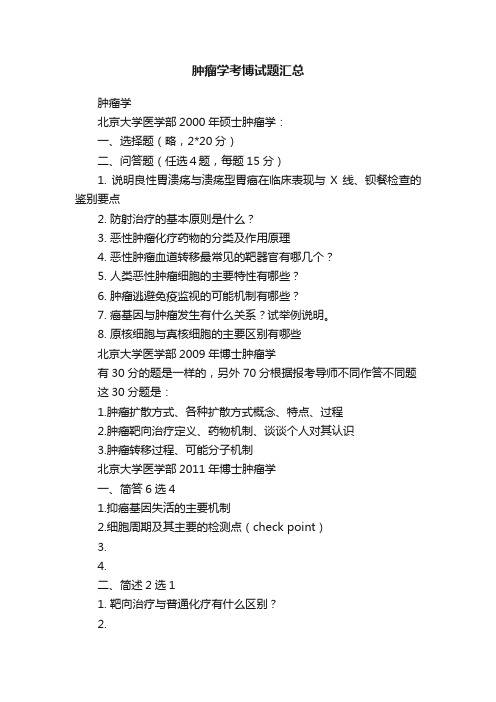
肿瘤学考博试题汇总肿瘤学北京大学医学部2000年硕士肿瘤学:一、选择题(略,2*20分)二、问答题(任选4题,每题15分)1. 说明良性胃溃疡与溃疡型胃癌在临床表现与X线、钡餐检查的鉴别要点2. 防射治疗的基本原则是什么?3. 恶性肿瘤化疗药物的分类及作用原理4. 恶性肿瘤血道转移最常见的靶器官有哪几个?5. 人类恶性肿瘤细胞的主要特性有哪些?6. 肿瘤逃避免疫监视的可能机制有哪些?7. 癌基因与肿瘤发生有什么关系?试举例说明。
8. 原核细胞与真核细胞的主要区别有哪些北京大学医学部2009年博士肿瘤学有30分的题是一样的,另外70分根据报考导师不同作答不同题这30分题是:1.肿瘤扩散方式、各种扩散方式概念、特点、过程2.肿瘤靶向治疗定义、药物机制、谈谈个人对其认识3.肿瘤转移过程、可能分子机制北京大学医学部2011年博士肿瘤学一、简答6选41.抑癌基因失活的主要机制2.细胞周期及其主要的检测点(check point)3.4.二、简述2选11. 靶向治疗与普通化疗有什么区别?2.三、论述题2选11. 肿瘤抗原是什么?请设计一个实验,发现新的肿瘤抗原,并在临床予以验证。
2. 肿瘤的细胞分型与分子分型有什么不同?分子分型在临床的应用。
前面三大题是公选题(60分)。
后面的题是每个老师不同。
(40分)四、名词解释1. 调节性T细胞2.树突状细胞五、简述题1. 乳腺癌的分子分型为哪五种?哪一种更接近乳腺癌干细胞?2. 肿瘤的免疫治疗分类,请举例说明。
3. 化疗耐药的形成机制,针对此如何制定乳腺癌的治疗策略?复旦大学医学院2005年博士肿瘤学一. 简答题1.影像学在肿瘤中的作用2.综合治疗的重要性及其原则3.我国临床实验分几期,各期目的4.恶性肿瘤的转移途径5.微创外科中的无瘤原则6.原癌基因的活化机理,并举例说明7.什么是细胞调亡?肿瘤调亡与肿瘤治疗的关系8.宫颈癌的发病机制二、问答题1.凋亡的形态学及生化特点2.肿瘤外科生物学概念、临床意义3.肿瘤综合治疗分几部分复旦大学医学院2006年博士肿瘤学6道选5道1.DNA 的2种修复机制2.肿瘤的组织学来源3.试述临床研究方案的内容及注意事项4.基因扩增的检测方法5.防止肿瘤转移的治疗及方向6.肿瘤和遗传相关性的2个方面郑州大学2007年博士肿瘤学一.名词解释(每题2分):1.MTD 2.BSC 3.DD 4.DFS 5.EGFR二.问答(每题10分(1.消化肿瘤的主要特点?2.何谓恶病质,主要处理原则?3.肿瘤急性溶解综合征表现及其防治?4.上腔静脉综合征?5.请为CHOP治疗失败或复发的惰性淋巴瘤患者设计一个比较好的化疗方案6.目前骨肉瘤主要的三个化疗药物?7.癌发生的两阶段学说?8.癌细胞进入淋巴管、血管的过程?9.说出FDA批准的四个靶向治疗药物的适应症。
临床医学肿瘤学习题+参考答案

临床医学肿瘤学习题+参考答案一、单选题(共100题,每题1分,共100分)1、癌症病人的QUL评估( )。
A、除终末期外,应由病人本人进行评估B、应由病人本人通过回答问卷完成评估C、病人自我评估受主观因素影响大,自我评估不可靠D、应由病人的家属进行评估E、应由医护人员进行评估正确答案:B2、下列哪种骨肿瘤化疗不作为主要治疗手段?( )A、骨肉瘤B、尤文肉瘤C、恶性纤维组织细胞瘤D、骨髓瘤E、软骨母细胞瘤正确答案:E3、早期声门区喉癌(T1N0M0)的合理治疗手段是( )。
A、手术+术后化疗B、仅行声带切除C、全喉切除+根治性放疗D、术前放疗+手术切除+术后同步放化疗E、根治性放疗正确答案:E4、不属于癌前病变的是( )。
A、乳腺导管内乳头状瘤B、子宫颈糜烂C、Barrett食管D、结肠多发性息肉E、萎缩性胃炎正确答案:B5、下面射线不属于高LET射线的是( )。
A、碳离子射线B、中子射线C、γ射线D、Α粒子E、质子射线正确答案:C6、随着肿瘤体积的增大,细胞对放疗的敏感性都有明显的下降,是由于( )。
A、以上均对B、肿瘤越大,加速再增殖越明显C、肿瘤越大,倍增时间越短D、肿瘤越大,生长比例越大E、肿瘤越大,乏氧细胞比例越大正确答案:E7、原发性肝癌按大体形态分型下述错误的是( )。
A、结节型易发生癌结节破裂出血B、巨块型易发生坏死引起肝破裂C、孤立的直径<5cm的癌结节称为小肝癌D、巨块型癌直径>10cmE、弥漫型往往因肝功能衰竭而死亡正确答案:A8、男,50岁,嗜酒吸烟,近3周来出现吞咽时胸骨后烧灼痛,门诊吞钡照片未发现明显异常。
为进一步明确诊断,应作的检查是( )。
A、食管镜检查或食管拉网细胞检查B、胸部X线摄片C、继续观察D、胸部CTE、大便潜血试验正确答案:A9、医技人员,指医疗机构内的( )。
A、医师B、助理医师C、药学技术人员D、从事其他技术服务的卫生专业技术人员E、护士正确答案:D10、男,28岁,近半年来腹泻与便秘交替发生,近3个月来腹部隐痛,近2天解鲜血便,腹部触诊和直肠指诊未发现肿块,钡灌肠示降结肠肠壁僵硬,可见充盈缺损。
南开大学病理生理学2019年考博真题考博试卷

医学考博真题试卷
南开大学医学院
第1页 共1页
2019 年攻读博士学位研究生学考试试题
考试科目:病理生理学 注意:所有答案一律写在答题纸上,写在试题纸上或其他地方一律不给分。
一、名词解释 代谢性碱中毒 肝性脑病 低钾血症 二、简答题 1 高钾血症酸碱代谢失衡的类型及心肌电生理特点 2MODS 的组织和代谢变化 3 肝纤维化的发病机制 4 肺换气功能障碍的类型和机制 5 全身缺氧的代偿和损伤变化 三、论述题 1 休克器官功能障碍的细胞机制 10 分 2 细胞功能障碍的方式,心血管疾病和肿瘤试述 15 分 3 缺血再灌注钙超载的作用机制 15 分 4 体液因素在损伤中的的作用方式简述,外泌体在衰老和肿瘤中的作用方式,机制 15 分
第1页 共1页
(完整)肿瘤学考博试题汇总,推荐文档
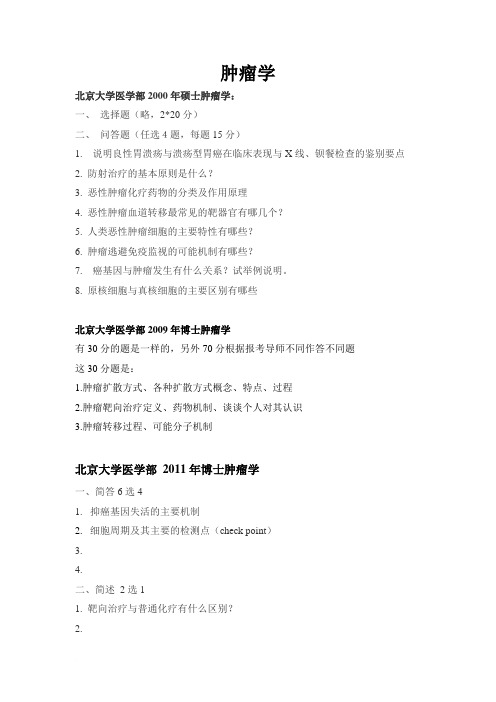
肿瘤学北京大学医学部2000年硕士肿瘤学:一、选择题(略,2*20分)二、问答题(任选4题,每题15分)1. 说明良性胃溃疡与溃疡型胃癌在临床表现与X线、钡餐检查的鉴别要点2. 防射治疗的基本原则是什么?3. 恶性肿瘤化疗药物的分类及作用原理4. 恶性肿瘤血道转移最常见的靶器官有哪几个?5. 人类恶性肿瘤细胞的主要特性有哪些?6. 肿瘤逃避免疫监视的可能机制有哪些?7. 癌基因与肿瘤发生有什么关系?试举例说明。
8. 原核细胞与真核细胞的主要区别有哪些北京大学医学部2009年博士肿瘤学有30分的题是一样的,另外70分根据报考导师不同作答不同题这30分题是:1.肿瘤扩散方式、各种扩散方式概念、特点、过程2.肿瘤靶向治疗定义、药物机制、谈谈个人对其认识3.肿瘤转移过程、可能分子机制北京大学医学部2011年博士肿瘤学一、简答6选41.抑癌基因失活的主要机制2.细胞周期及其主要的检测点(check point)3.4.二、简述2选11. 靶向治疗与普通化疗有什么区别?2.三、论述题2选11. 肿瘤抗原是什么?请设计一个实验,发现新的肿瘤抗原,并在临床予以验证。
2. 肿瘤的细胞分型与分子分型有什么不同?分子分型在临床的应用。
前面三大题是公选题(60分)。
后面的题是每个老师不同。
(40分)四、名词解释1. 调节性T细胞2.树突状细胞五、简述题1. 乳腺癌的分子分型为哪五种?哪一种更接近乳腺癌干细胞?2. 肿瘤的免疫治疗分类,请举例说明。
3. 化疗耐药的形成机制,针对此如何制定乳腺癌的治疗策略?复旦大学医学院2005年博士肿瘤学一. 简答题1.影像学在肿瘤中的作用2.综合治疗的重要性及其原则3.我国临床实验分几期,各期目的4.恶性肿瘤的转移途径5.微创外科中的无瘤原则6.原癌基因的活化机理,并举例说明7.什么是细胞调亡?肿瘤调亡与肿瘤治疗的关系8.宫颈癌的发病机制二、问答题1.凋亡的形态学及生化特点2.肿瘤外科生物学概念、临床意义3.肿瘤综合治疗分几部分复旦大学医学院2006年博士肿瘤学6道选5道1.DNA 的2种修复机制2.肿瘤的组织学来源3.试述临床研究方案的内容及注意事项4.基因扩增的检测方法5.防止肿瘤转移的治疗及方向6.肿瘤和遗传相关性的2个方面郑州大学2007年博士肿瘤学一.名词解释(每题2分):1.MTD 2.BSC 3.DD 4.DFS 5.EGFR二.问答(每题10分(1.消化肿瘤的主要特点?2.何谓恶病质,主要处理原则?3.肿瘤急性溶解综合征表现及其防治?4.上腔静脉综合征?5.请为CHOP治疗失败或复发的惰性淋巴瘤患者设计一个比较好的化疗方案6.目前骨肉瘤主要的三个化疗药物?7.癌发生的两阶段学说?8.癌细胞进入淋巴管、血管的过程?9.说出FDA批准的四个靶向治疗药物的适应症。
临床肿瘤学试题及标准答案(--)

临床肿瘤学试题及答案(--)————————————————————————————————作者:————————————————————————————————日期:临床肿瘤学第一阶段试题(2004)一、单项选择题(每题1分,共30题)1.防止抗肿瘤药物局部栓塞性静脉炎的方法:(A)A.滴管内快速滴入B.局部热敷C.局部冷敷D.局部0.25%普鲁卡因封闭E.大量液体稀释后滴入2.博莱霉素的毒性作用主要为:(D)A.药物性肝炎B.出血性膀胱炎C.骨髓抑制D.肺纤维化E.中毒性心肌炎3 早期肿瘤细胞增长方式为:(A)A.按指数方式增长B.按一定百分率增长C.按倍数方式增长D.增长方式无规律E.阶梯式增长4.治疗恶性黑色素瘤的首选药物:(B)A.环磷酰胺B.氮烯咪胺C.阿霉素D.氟脲嘧啶E.顺铂5.单用化疗药物,可使下列哪种肿瘤获得治愈的机会最大:(A) A.绒癌B.多发性骨髓瘤C.肾癌D.卵巢癌E.小细胞肺癌6.睾丸精原细胞瘤的病因与下列因素有关:(B)A.既往有睾丸结核B.隐睾或异位睾丸C.病毒感染D:睾丸炎症E:与放射线照射有关7.亚硝脲类抗肿瘤药物治疗脑肿瘤的机理:(C)A:影响瘤细胞DNA的合成B:主要影响瘤细胞膜的作用C:脂溶性药物易透过血脑屏障D:影响瘤细胞的转录过程E:使肿瘤细胞的有丝分裂受阻8.抗肿瘤药物之所以不能根治肿瘤的原因:(D)A:剂量不够大B:耐药性产生,肿瘤细胞不敏感C:肿瘤细胞负荷太大D:细胞动力学中,有G0期细胞存在E:免疫力低下,不能接受反复化疗9.芳香化酶抑制剂治疗晚期乳腺癌的机理()A:细胞毒药物,影响DNA的复制B:药物性垂体切除术C:抑制雄激素向雌激素转化D:直接杀伤乳癌细胞E:免疫调节剂,抑制肿瘤血管生成。
10.炎性乳腺癌的临床治疗原则(C)A:手术→放疗→化疗B:放疗→手术→化疗C:化疗→手术→放疗D:放疗→化疗→手术E:手术→化疗→放疗11.鼻烟部位多形T细胞非霍奇金氏淋巴瘤临床分期IIA首选治疗为:(C) A:手术B:放疗C:化疗D:免疫治疗E:基因治疗12.紫杉醇的抗肿瘤的原理为:(A)A:促进微管的聚合,抑制微管网的正常重组B:促进微管拆卸,导致微管的分解C:拓扑异构酶I抑制剂,导致DNA的损伤D:拓扑异构酶II抑制剂,影响DNA的损伤E:经脱氧胞嘧啶激酶活化,作用于S期。
肿瘤学试卷试题库题集.doc
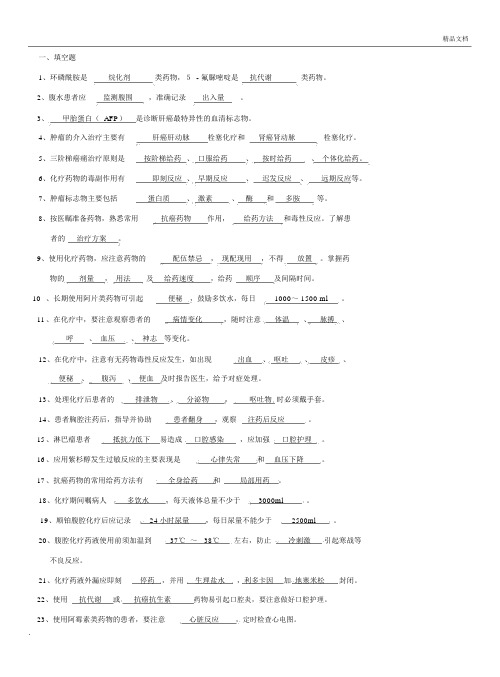
精品文档一、填空题1、环磷酰胺是烷化剂类药物,5 - 氟脲嘧啶是抗代谢类药物。
2、腹水患者应监测腹围,准确记录出入量。
3、甲胎蛋白( AFP)是诊断肝癌最特异性的血清标志物。
4、肿瘤的介入治疗主要有肝癌肝动脉栓塞化疗和肾癌肾动脉栓塞化疗。
5、三阶梯癌痛治疗原则是按阶梯给药、口服给药、按时给药、个体化给药。
6、化疗药物的毒副作用有即刻反应、早期反应、迟发反应、远期反应等。
7、肿瘤标志物主要包括蛋白质、激素、酶和多胺等。
8、按医瞩准备药物,熟悉常用抗癌药物作用,给药方法和毒性反应。
了解患者的治疗方案。
9、使用化疗药物,应注意药物的配伍禁忌,现配现用,不得放置。
掌握药物的剂量,用法及给药速度,给药顺序及间隔时间。
10 、长期使用阿片类药物可引起便秘,鼓励多饮水,每日1000~ 1500 ml 。
11 、在化疗中,要注意观察患者的病情变化,随时注意体温、脉搏、呼、血压、神志等变化。
12、在化疗中,注意有无药物毒性反应发生,如出现出血、呕吐、皮疹、便秘、腹泻、便血及时报告医生,给予对症处理。
13、处理化疗后患者的排泄物、分泌物,呕吐物时必须戴手套。
14、患者胸腔注药后,指导并协助患者翻身,观察注药后反应。
15 、淋巴瘤患者抵抗力低下易造成口腔感染,应加强口腔护理。
16 、应用紫杉醇发生过敏反应的主要表现是心律失常和血压下降。
17 、抗癌药物的常用给药方法有全身给药和局部用药。
18、化疗期间嘱病人多饮水,每天液体总量不少于3000ml 。
19、顺铂腹腔化疗后应记录24 小时尿量,每日尿量不能少于2500ml 。
20、腹腔化疗药液使用前须加温到37℃~38℃左右,防止冷刺激引起寒战等不良反应。
21、化疗药液外漏应即刻停药,并用生理盐水,利多卡因加地塞米松封闭。
22、使用抗代谢或抗癌抗生素药物易引起口腔炎,要注意做好口腔护理。
精品文档24、肝癌患者发生皮肤搔痒,可用 1 %薄荷乙醇溶液外涂,不可用力搔抓皮肤,以免皮肤破溃感染。
临床医学肿瘤学模考试题(含参考答案)

临床医学肿瘤学模考试题(含参考答案)一、单选题(共100题,每题1分,共100分)1、通常所指的头颈部肿瘤除外的是( )。
A、脑胶质瘤B、外耳道鳞癌C、口腔癌D、甲状腺癌E、鼻咽癌正确答案:A2、医学公益观的主要内容不包括( )。
A、社会道德论B、兼容论C、兼顾论D、社会福利论E、社会效益论正确答案:D3、原发性肝癌的临床特点错误的是( )。
A、肿瘤生长缓慢,可以无痛B、肿块增长迅速,肝包膜被牵拉引起疼痛C、癌块侵犯肝门胆管引起黄疸D、门脉外癌栓可以产生血管杂音E、门脉内癌栓可导致门脉高压正确答案:D4、西妥昔单抗的作用靶点是( )。
A、EGFRB、CD20C、VEGFD、CD52E、Her-2正确答案:A5、当一个晚反应组织中出现了早反应组织性质的肿瘤,在进行根治性放疗时,你认为下列合理的是( )。
A、延长总的治疗时间B、常规治疗降低总照射剂量C、以上都不对D、可在疗程中考虑超分割放射治疗E、常规治疗提高分次照射剂量正确答案:D6、下列哪一征象最能提示胆囊癌的诊断?( )A、胆总管和肝内胆管扩张B、胆囊周围水肿明显C、胆囊缩小D、胆囊壁钙化E、囊壁不规则增厚正确答案:E7、原发性肝细胞癌的AFP阳性率是( )。
A、60%~70%B、70%~90%C、100%D、80%~90%E、50%~60%正确答案:A8、在临床放射治疗计划中关于等效生物剂量的考虑,下面说法不正确的是( )。
A、当放疗不良反应导致治疗中断时间较长,仍可按照原计划进行B、当放疗不良反应导致治疗中断时间较长,要根据肿瘤生物学规律重新评价生物效应剂量C、不同阶段放射治疗等效生物剂量可以直接相加D、改变常规治疗计划时应该保持相等生物效应所需的总剂量E、在进行等效生物剂量换算时,要根据肿瘤本身的生物学规律选择合适的数学模型正确答案:A9、乳腺癌主要发生于女性,男性乳腺癌约占( )。
A、2%B、0.5%C、1.5%D、1%E、2.5%正确答案:D10、下列属于规范化癌症疼痛处理的目的是( )。
临床肿瘤学试题及答案(2-00-4)
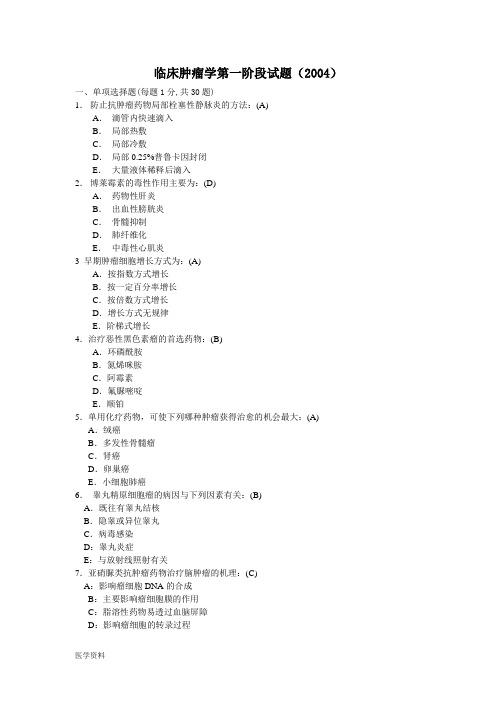
临床肿瘤学第一阶段试题(2004)一、单项选择题(每题1分,共30题)1.防止抗肿瘤药物局部栓塞性静脉炎的方法:(A)A.滴管内快速滴入B.局部热敷C.局部冷敷D.局部0.25%普鲁卡因封闭E.大量液体稀释后滴入2.博莱霉素的毒性作用主要为:(D)A.药物性肝炎B.出血性膀胱炎C.骨髓抑制D.肺纤维化E.中毒性心肌炎3 早期肿瘤细胞增长方式为:(A)A.按指数方式增长B.按一定百分率增长C.按倍数方式增长D.增长方式无规律E.阶梯式增长4.治疗恶性黑色素瘤的首选药物:(B)A.环磷酰胺B.氮烯咪胺C.阿霉素D.氟脲嘧啶E.顺铂5.单用化疗药物,可使下列哪种肿瘤获得治愈的机会最大:(A) A.绒癌B.多发性骨髓瘤C.肾癌D.卵巢癌E.小细胞肺癌6.睾丸精原细胞瘤的病因与下列因素有关:(B)A.既往有睾丸结核B.隐睾或异位睾丸C.病毒感染D:睾丸炎症E:与放射线照射有关7.亚硝脲类抗肿瘤药物治疗脑肿瘤的机理:(C)A:影响瘤细胞DNA的合成B:主要影响瘤细胞膜的作用C:脂溶性药物易透过血脑屏障D:影响瘤细胞的转录过程E:使肿瘤细胞的有丝分裂受阻8.抗肿瘤药物之所以不能根治肿瘤的原因:(D)A:剂量不够大B:耐药性产生,肿瘤细胞不敏感C:肿瘤细胞负荷太大D:细胞动力学中,有G0期细胞存在E:免疫力低下,不能接受反复化疗9.芳香化酶抑制剂治疗晚期乳腺癌的机理()A:细胞毒药物,影响DNA的复制B:药物性垂体切除术C:抑制雄激素向雌激素转化D:直接杀伤乳癌细胞E:免疫调节剂,抑制肿瘤血管生成。
10.炎性乳腺癌的临床治疗原则(C)A:手术→放疗→化疗B:放疗→手术→化疗C:化疗→手术→放疗D:放疗→化疗→手术E:手术→化疗→放疗11.鼻烟部位多形T细胞非霍奇金氏淋巴瘤临床分期IIA首选治疗为:(C) A:手术B:放疗C:化疗D:免疫治疗E:基因治疗12.紫杉醇的抗肿瘤的原理为:(A)A:促进微管的聚合,抑制微管网的正常重组B:促进微管拆卸,导致微管的分解C:拓扑异构酶I抑制剂,导致DNA的损伤D:拓扑异构酶II抑制剂,影响DNA的损伤E:经脱氧胞嘧啶激酶活化,作用于S期。
医学考博2019真题

Listening :无Vocabulary :Section A31. According to the Geneva ______no prisoners of war shall be subject to abuse.A. CustomsB. CongressesC. ConventionsD. Routines 32. Environmental officials insist that something be done to ______acid rain.A. curbB. sueC. detoxifyD. condemn33. It is impossible to say how it will take place, because it will happen______, and itwill not be a long process.A. spontaneouslyB. simultaneouslyC. principallyD. approximately34. Diabetes is one of the most______ and potentially dangerous disease in the world.A. crucialB. virulentC. colossalD. prevalent35. Rheumatologist advises that those with ongoing aches and pains first seek medicalhelp to ______the problem.A. affiliateB. alleviateC. aggravateD. accelerate36. How is it possible that such______ deception has come to take place right underour noses?A. obviousB. significantC. necessaryD. widespread37. Now a paper in Science argues that organic chemicals in the rock come mostly from______on earth rather than bacteria on Mars.A. configurationB. constitutionC. condemnationD. contamination38. Chronic high-dose intake of vitamin A has been shown to have ______effects onbones.A. adverseB. prevalentC. instantD. purposeful39. Generally, vaccine makers _____ the virus in fertilized chicken eggs in a processthat can take four to six months.A. penetrateB. designateC. generateD. exaggerate40. We are much quicker to respond, and we respond far too quickly by giving ______to our anger.A. ventB. impulseC. temperD. offenceSection B41. The patient's condition has worsened since last night.A. improvedB. returnedC. deterioratedD. changed42. Beijing Television-Station Transmitting Tower really looks magnificent at nightwhen it ’s lit up.A. decoratedB. illustratedC. illuminatedD. entertained43. Attempts to restrict parking in the city centre have further aggravated the problemof traffic congestion.A. amelioratedB. aggregatedC. deterioratedD. duplicated44. The applications of genetic engineering are abundant and choosing oneappropriate for this case can be rather difficult.A. sufficientB. plentifulC. adequateD. countable45. The defect occurs in the first eight weeks of pregnancy, though no one understandswhy.A. deficitB. deviationC. draw backD. discrepancy46. He has been on hormone alternate therapy for four years and looks fantastic.A. successorB. replacementC. surrogateD. choice47. It had over 2,000 apartment complexes, a great market, a large number ofindustrial workshops, an administrative center, a number of massive religious edifices,and a regular grid pattern of streets and buildings.A. ancientB. carefullyC. very largeD. carefully protected48. When patients spend extended periods in hospital, they tend to become overlydependent and lose interest in taking care of themselves.A. extremelyB. exclusivelyC. exactlyD. explicitly49. The anxious parent was vigilant over the injured child in spite of a full array ofemergency room of doctors and nurses.A. preoccupiedB. unwaryC. watchfulD. dozing50. The doctor vacillated so frequently on disease-preventiontechniques that hiscolleagues accused him of inconsistency.A. waveredB. instigatedC. experimentedD. reliedClozeWe spend a lot of time looking at the eyes of others for social 51 —it helpsus understand a person ’emotions, and make decisions about how to respond to them. We also know that adults avoid eye contact when anxious. But researchers have knownfar 52 about eye gazing patterns in children.According to new research by Kalina Michalska, assistant professor of psychologyat the University of California, Riverside, we now, know that anxious children tend toavoid making eye contact, and this has consequences for how they experience fear. The53 and less frequently they look at the eyes of others, the more likely they are to beafraid of them, even when there may be no reason to be. Her study, “Anxiety Sympand Children's Eye Gaze During Fear Leaming”w,as published in the journal TheJournal of Child Psychology and Psychiatry."Looking at someone ’s eyes helps us understand whether a person is feeling sad, angry, fearful, or surprised. As adults, we then make decisions about how to respondand what to do next. But, we know much less about eye patterns in children —so,understanding those patterns can help us learn more about the development of sociallearning, ”Michalska said.Michalska and the team of researchersshowed 82 children, 9 to 13 years old,images of two women ’s faces on a computer screen. The computer was equipped withan eye tracking device that allowed them to measure54 on the screen children werelooking, and for how long. The participants were originally shown each of the twowomen a total of four times. Next, one of the images was55 with a loud scream anda fearful expression, and the other one was not. At the end, children saw both facesagain without any sound or scream.The following three conclusions can be drawn from the study:1. All children spent more time looking at the eyes of a face that was paired withthe loud scream t han the face that was not paired with the scream, 56 they payattention to potential threats even in the absence of outward cues.2. Children who were more anxious avoided eye contact during all three phases of the experiment, for both kinds of faces. This had consequences for how afraid they wereof the faces.3. The more children avoided eye conta;cthe more afraid they were 57 the faces.The conclusions suggest that children spend more time looking at the eyes of aface when previously paired with something frightening suggesting they pay moreattention to potentially threatening information as a way to learn more about thesituation and plan what to do next.However, anxious children tend to avoid making eye contact, which leads togreater 58 experience. Even though avoiding eye contact may reduce anxiety59 , the study finds that — over time — children may be m i s s6i n0g_ o i m u p t ortantsocial information. This includes that a person may no longer be threatening or scary,and yet the child continues feeling fearful of that person.51. A. environment B. cues C. relations D. answers52. A. less B. more C. enough D. beyond53. A. longer B. more anxious C. shorter D. more54. A. where B. when C. how D. what55. A. followed B. recorded C. paired D. marked56. A. suggest B. suggesting C. suggests D. being suggested57. A. to B. of C.at D. about58. A. fear B. surprise C. sad D. angry59. A. in the long run B. for a long timeC. in the short timeD. in a long time60. A. with B. without C. of D. onReading ComprehensionPassage OneThe British psychoanalyst John Bowlby maintains that separation from the parentsduring the sensitive “attachment p”e riod from birth to three may scar a child ’s personality and predispose to emotional problems in later life.Some people have drawn the conclusion from Bowlby' s work that children shouldnot be subjected to day care before the age of three because of the parental separationit entails, and many people do believe this. It has been argued that an infant under threewho is cared for outside the home may suffer because of the separation from his parents. But there are also arguments against such a strong conclusion.But traditional societies are so different from modem societies that comparisonsbased on just one factor are hard to interpret. Firstly, anthropologists point out that theinsulated love affair between children and parents found in modem societies does notusually exist in traditional societies. For example, in some tribal societies, such as theNgoni, the father and mother of a child did not rear their infant alone —far from i Certainty, Bowlby ’s analysis raises the possibilities that early day care had delayedeffects. The possibility that such care might lead to, say, more mental illness or crime15 or 20 years later can only explored by the use of statistics. However, statisticalstudies of this kind have not yet been carried out, and even if they were, the resultswould certainly be complicated and controversial. Secondly, common sense tells us that day care would not be so widespread today if parents, care-takers found children hadproblems with it. Thirdly, in the last decade, t here have been a number of careful American studies of children in day care, and they have uniformly reported that care had a neutral or slightly positive effect on children ’s development.Whatever the long-term effects, parents sometimes find the immediate effectsdifficult to deal with. Children under three are likely to protest at leaving their parentsand show unhappiness. At the age of three or three and a half almost all children findthe transition to nursery eas,yand this is undoubtedly why more and more parents make use of child care at this time. The matter, then, is far from clear-cut, though experienceand available evidence indicate early care is reasonable for infants.61. According to the passage, the consequence of parental separation________.A. still needs more statistical studiesB. has been found negative is more seriousC. is obviousD. in modem times62. The author thinks that John Bowlby ’s concern___________.A. is relevant and justifiableB. is too strong to RelieveC. is utterly groundlessD. has something that deserve our attention63. What ’s the result of American studies of children in day care in the last decade?A. The children ’s unhappiness and protest was due to the day care the children received.B. The bad effects of parental separation were hard to deal with.C. The effect of day care was not necessarily negative on children ’s development.D. Early care was reasonable for babies since it ’p sracti c ed by so many peoplenowadays.64. According to the passage, which of the following is probably a reason forparents to send their children under three to day care?A. They don ’t know about day care ’s negative effect.B. They are too busy to care fortheir children.C. They want their children to be independent as early as possible.D. They want to facilitate their children to adapt to nursery at the age of about three.65. What ’s the author ’s attitude to people who have drawn the conclusion fromBowlby’s work that children should not be subjected to day care before the age ofthree?A. He supports most of their belief because Bowlby's proposition is well-grounded.B. He is sympathetic for them, for he thinks they have been misled by Bowlby.C. He doesn't totally agree with them, since the long-term effect of day care still needsfurther study.D. He doesn't quite understand them, as they are contradictory in themselves.Passage TwoBy the end of this century, the average world temperature is expected to increasebetween one and four degrees, with widespread effects on rainfall, sea levels and animalhabitats. But in the Arctic, where the effects of climate change are most intense, the risein temperature could be twice as much.Understanding how Arctic warming will affect the people, animals, plant andmarine life and economic activity in Canada’N sort h are important to the country's future, says Kent Moore, an atmospheric physicist at University of Toronto Mississaugawho is participating in a long-term, international study of the marine ecosystem alongthe Beaufort Sea, from Alaska to the Mackenzie delta.The study will add to our knowledge of everything from the extent of sea ice inthe region to how fish stocks will change to which areas could become targets for oiland gas exploration to the impact on the indigenous people who call this part of thecountry home.Moore, who has worked in the Arctic for more than 20 years, says his research hasalready found that thinning sea ice and changes in wind patterns are causing animportant change in the marine food chain: phytoplankton(淳游植物) is blooming two to three weeks earlier. Manyanimals time their annual migration to the Arctic forwhen food is plentiful, and have not adapted to the earlier bloom. " ' Animals' behaviorcan evolve over a long time, but these climate changes are happening in the space of adecade, r ather than hundreds of years, ”says Moore, " Animals can't change theirbehavior that quickly. ”A warmer Arctic is expected to have important effects on human activity in theregion, as the Northwest Passage becomes navigable during the summer, and resourceextraction becomes more feasible. Information gained from the study will helpgovernment, industry and communities make decisions about resource management,economic development and environmental protection.Moore says the study — which involves Canadian, American and Europeanresearchersand government agencies will also use a novel technology to gatheratmospheric data: remotely piloted drones. "The drones have the capability of a largeresearch aircraft,and they ’re easier to deploy, ” he says, showing the researchers to gather information on a more regular basis than they would be able to with pilotedaircraft.66. By the end of this century, according to the author, global warming will ______.A. start to bring about extreme weather events to humans and animalsB. increase the average world temperature by four degreesC. cause more damages to the whole world than expectedD. affect the Arctic more than any other parts of the earth67. To help understand the destructive mechanism of Arctic warming, as indicatedby the passage, the international study ______.A. is conducted with every single discipline of University of TorontoB. pioneers in pursuing the widespread effects of climate changeC. involves so many countries for different investigationsD. is intended to deal with various aspects in research68. When he ways, “Animals can ’t change their behavior that quickly, ”what doesMoore mean by that quickly?A. The migration of the animals to the Arctic.B. The widespread effects of global warming.C. The rate of the climate change in the Arctic.D. The phytoplankton within the marine ecosystem.69. According to the author, to carry out proper human activities in theArctic______.A. becomes more difficult than ever beforeB. is likely to build a novel economy in the regionC. will surely lower the average world temperatureD. needs the research-based supporting information70. With the drones deployed, as Moore predicts, the researchers will _______.A. involve more collaborating countries than they do nowB. get more data to be required for their researchC. use more novel technologies in researchD. conduct their research at a regular basisPassage ThreeHaving too much caffeine during pregnancy may impair baby ’s liver development and increase the risk of liver disease in adulthood, according to a study published in theJournal of Endocrinology. Pregnant rats given caffeine had offspring with lower birth weights, altered growth and stress hormonelevels and impaired liver development. Thestudy findings indicate that consumption of caffeine equivalent to 2-3 cups of coffee may alter stress and growth hormone levels in a manner that can impair growth and development, and increase the risk of liver disease in adulthood.Previous studies have indicated that prenatal caffeine intake of 300 mg/day ormore in women, which is approximately 2 to 3 cups coffee per day, can result in lower birth weights of their children. Animalstudies have further suggestedthat prenatalcaffeine consumption may have more detrimental long-term effects on liverdevelopment with an increased susceptibility to non-alcoholic fatty liver disease, adebilitating condition normally associated w ith obesity and diabetes. However, theunderlying link between prenatal caffeine exposure and impaired liver developmentremains poorly understood. A better understanding of how caffeine mediates theseeffects could help prevent these health issues in people in the future.In this study, Prof Hui Wang and colleagues at Wuhan University in China,investigated the effects of low (equivalent to 2-3 cups of coffee) and high dose(equivalent of 6-9 cups of coffee) caffeine, given to pregnant rats, on liver function andhormone levels of their offspring. Offspring exposed to prenatal caffeine had lower levels of the liver hormone, insulin likegrowth factor (IGF-1), and higher levels of thestress hormone, corticosteroid at birth. However, liver development after birth showed a compensatory 'catch up' phase, characterised by increased levels of IGF-1, which is important for growth.Dr. Yinxian Wen, study co-author, says, “Our results indicate that prenatal caffeine causes an excess of stress hormone activity in the mother, which inhibits IGF-1 activityfor liver development before birth. However, compensatory mechanisms do occur after birth to accelerate growth and restore normalliver function, as IGF-1 activity increasesand stress hormone signalling decreases. The increased risk of fatty liver disease causedby prenatal caffeine exposure is most likely a consequence of this enhanced,compensatory postnatal IGF-1 activity. ”These findings not only confirm that prenatal caffeine exposure leads to lowerbirth weight and impaired liver development before birth but also expand our currentunderstanding of the hormonal changes underlying these changes and suggest thepotential mechanism for increased risk of liver disease in the future. However, theseanimal findings need to be confirmed in humans.Dr. Wen comments, "Our work suggeststhat prenatal caffeine is not good for babies and although these findingsstill need to be confirmed in people, I wouldrecommend that women avoid caffeine during pregnancy."71. Which of the following is NOT the problem of baby rats of pregnant rats givencaffeine?A. Lower birth weight.B. Smaller stress.C. Liver development problem.D. Growth problem.72. If a pregnant woman takes 3 cups of coffee, what will probably happen?A. Her weight will get lower and lower.B. The weight of her baby will get lower and lower.C. She will suffer from non-alcoholic fatty liver disease in a long run.D. Her baby will be more vulnerable to obesity and diabetes because of liver problem.73. Which of following is not correct according to the passage?A. A better understanding of the relationship between caffeine and effects has beenachieved.B. 4-5 cups of coffee could be categorized as medium-dose intake.C. Liver development problem may be remedied after birth by increased growth factor.D. The study is mainly conducted on the rats instead of human.74. What is the relationship between stress hormone and liver development whentaking in prenatal caffeine?A. Lower stress hormone, lower birth weight before birth.B. Higher stress hormone, lower growth hormone before birth.C. Higher stress hormone, more accelerated growth of weight after birth.D. Lower stress hormone, less accelerated growth of liver after birth.75. What can be the best summary of the last paragraph?A. The research hasn ’t been done on humans so pregnant women can ignore the results.B. The compensatory mechanism for liver growth makes prenatal caffeine intake safe.C. Experts suggest pregnant women should still avoid caffeine.D. We have known enough about the hormone changes underlying the healthPassage FourThe bizarre antics of sleepwalkers have puzzled police, perplexed scientists, and fascinated writers for centuries. There is an endless supply of stories about sleepwalkers.Persons have been said to climb on steep roofs, solve mathematical problems, composemusic, walk through plate-glass windows, and commit murder in their sleepHow many of these stories have a basis in fact, and how many are pure fakery?No one knows, but if some of the most sensational stories should be taken with a barrelof salt, others are a matter of record.In Revere, Massachusetts, a hundred policemen combed a waterfrontneighborhood for a lost boy who left his home in his sleep and woke up five hours lateron a strange sofa in a strange living room, with no idea how he had got there.There is an early medical record of a somnambulist who wrote a novel in his sleep.And the great French writer V oltaire knew a sleepwalker who once got out of bed,dressed himself, made a polite bow, danced a minuet, and then undressed and went backto bed.At the University of Iowa, a student was reported to have the habit of getting upin the middle of the night and walking three-quarters of a mile to the Iowa River. He would take a swim and then go back tohis room to bed.The world's champion sleepwalker was supposed to have been an Indian, PanditRamrakha, who walked sixteen miles along a dangerous road without realizing that hehad left his bed. Second in line for the title is probably either a Vienna housewife or a British farmer. The woman did all her shopping on busy streets in her sleep. The farmer,in his sleep, visited a veterinarian miles away.The leading expert on sleep in America claims that he has never seen a sleepwalker.He is Dr. Nathaniel Kleitman, a physiologist at the University of Chicago. He is said toknow more about sleep than any other living man, and during the last thirty-five yearshad lost a lot of sleep watching people sleep. Says he, "Of course, I know that there are sleepwalkers becauseI have read about them in the newspapers. B ut none of mysleepers ever walked, and if I were to advertise for sleepwalkers for an experiment, Idoubt that I'd get many takers."Sleepwalking, nevertheless, is a scientific reality. Like hypnosis, it is one of thosedramatic, eerie, awe-inspiring phenomena that sometimes border on the fantastic. Itlends itself to controversy and misconceptions, what is certain about sleepwalking isthat it is a symptom of emotional disturbance, and that the only way to cure it is to remove the worries and anxieties that cause it. Doctors say that somnambulism is muchmore common than is generally supposed.Some have estimated that there are fourmillion somnambulists in the United States. Others set the figure even higher. Manysleepwalkers do not seek help and so are never put on record, which means that anaccurate count can never be made.The simplest explanation of sleepwalking is that it is the acting out of a vividdream. The dream usually comes from guilt, worry, nervousness, o r some otheremotional conflict. The classic sleepwalker is Shakespeare ’L asdy Macbeth. Hernightly wanderings were caused by her guilty conscience at having committed murder. Shakespeare said of her, “The eyes are open but their sense is shut. ”The age-old question is: Is the sleepwalker actually awake or asleep. Scientists have decided that he is about half-and-half. Like Lady Macbeth, he has weightyproblems on his mind. Dr. Zeida Teplitz, who made a ten-year study of the subject, says, “Some people stay awake all night worrying about t heir problems. The sleepwalker thrashes them out in his sleep. He is awake in the muscular area, partially asleep in the sensory area." In other words, a person can walk in his sleep, move around, and do other things, but he does not think about what he is doing.76. The second sentence in the second paragraph means that_________.A. no one knows, but certainly all the sleep walking stories have something incredibleB. the sleepwalking stories are like salt adding flavor to people ’s lifeC. sleepwalking stories that are most fantastic should be sorted out from ordinary storiesD. the most fantastic sleepwalking stories may be just fictions, yet there are stilltruthfully recorded stories77. ________was supposed to be the world's champion sleepwalker.A. The student habitually walked to the Iowa River and swam in his sleepB. The man danced a minuet in his sleepC. The man walker sixteen miles along a dangerous roadD. The boy walked five hours in his sleep78. Sleepwalking is the result of ______ according to the passage.A. emotional disorderB. a vivid dreamC. lack of sleep and great anxietyD. insanity79. Dr. Zeida Teplitz seemed to_________.A. agree that sleepwalking sometimes leads to dangerous actsB. conclude that sleepwalkers are awake in their sensory areaC. disagree with the belief that sleep walkers are immune to injuryD. think that sleepwalking can turn into madness80. The writer makes it obvious that_________.A. sleepwalkers are often awakened by dangersB. most sleepwalkers can find ways to avoid self-injuryC. it is important to find out the underlying cause of sleepwalkingD. sleepwalking is actually a kind of hypnosisPassage FiveBeyond the basic animal instincts to seek food and avoid pain, Freud identifiedtwo sources of psychic energy, which he called "drives ”: aggression and libido. The keto his theory is that these were unconscious drives, shaping our behavior without themediation of our waking minds; they surface, heavily disguised, only in our dreams.The work of the past half-century in psychology and neuroscience has been to downplaythe role of unconscious universal drives, focusing instead on rational processesinconscious life. But researchers have found evidence that Freud s drives really do exist,and they have their roots in the limbic system, a primitive part of the brain that operatesmostly below the horizon of consciousness.Now more commonly referred to as emotions, the modem suite of drives comprises five: rage, panic, separation distress,lust and a variation on libido sometimes called seeking.The seeking drive is proving a particularly fruitful subject for researchers.Although like the others it originates in the limbic system, it also involves parts of theforebrain, the seat of higher mental functions. In the 1980s, Jaak Panksepp, aneurobiologist at Bowling Green State University in Ohio, became interested in a placenear the cortex known as the ventraltegmental area, which in humans lies just abovethe hairline. When Panksepp stimulated the corresponding region in a mouse, theanimal would sniff the air and walk around, as though it were looking for something.Was it hungry? No. The mouse would walk right by a plate of food, or for that matterany other object Panksepp could think of. This brain tissue seemed to cause a generaldesire for something new. “What I was seeing, ” he says, “was the urge to do stuff.Panksepp called this seeking.To neuropsychologist Mark Solms of University College in London, that soundsvery much like libido. “Freud needed some sort of general, appetitive desire to seekpleasure in the world of objects, ” says Solms. "Panksepp discovered as a neuroscientist what Freud discovered psychologically. ” Solms studied the same region of the brain forhis work on dreams. Since the 1970s, neurologists have known that dreaming takesplace during a particular form of sleep known as REM — rapid eye movement — whichis associated with a primitive part of the brain known as the pons. Accordingly, they regarded dreaming as a low-level phenomenon of no great psychological interest. WhenSolms looked into it, though, it turned out that the key structure involved in dreaming was actually the ventral tegmental, the same structure that Panksepp had identified as the seat of the “”s e e m k i o n t g i o n. Dreams, it seemed, originate with the libid—o which is just what Freud had believed.Freud's psychological map may have been flawed in many ways, but it alsohappensto be the most coherent and, from the standpoint of individual experience,meaningful theory of the mind. “Freud should be placed in the same category as Darwin,who lived before the discovery of genes, ” says Panksepp. “Freud gave us a vision ofmental apparatus. We need to talk about it, develop it, test it. ” Perhaps it ’sof proving Freud wrong or right, but of finishing the job.。
临床医学肿瘤学选择题考试题与答案
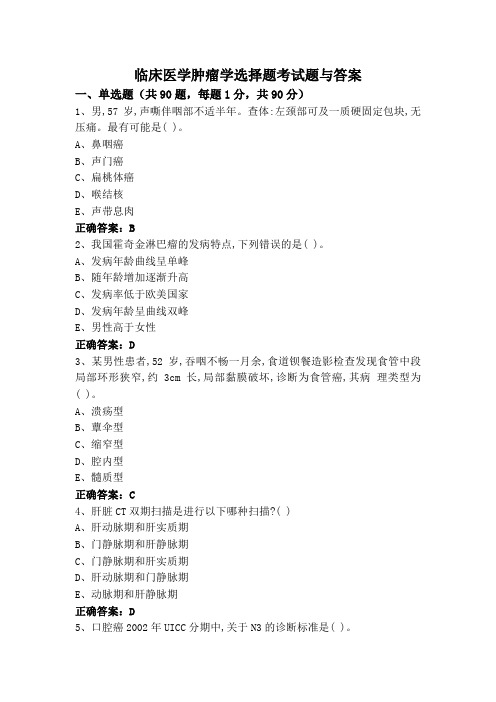
临床医学肿瘤学选择题考试题与答案一、单选题(共90题,每题1分,共90分)1、男,57岁,声嘶伴咽部不适半年。
查体:左颈部可及一质硬固定包块,无压痛。
最有可能是( )。
A、鼻咽癌B、声门癌C、扁桃体癌D、喉结核E、声带息肉正确答案:B2、我国霍奇金淋巴瘤的发病特点,下列错误的是( )。
A、发病年龄曲线呈单峰B、随年龄增加逐渐升高C、发病率低于欧美国家D、发病年龄呈曲线双峰E、男性高于女性正确答案:D3、某男性患者,52岁,吞咽不畅一月余,食道钡餐造影检查发现食管中段局部环形狭窄,约3cm长,局部黏膜破坏,诊断为食管癌,其病理类型为( )。
A、溃疡型B、蕈伞型C、缩窄型D、腔内型E、髓质型正确答案:C4、肝脏CT双期扫描是进行以下哪种扫描?( )A、肝动脉期和肝实质期B、门静脉期和肝静脉期C、门静脉期和肝实质期D、肝动脉期和门静脉期E、动脉期和肝静脉期正确答案:D5、口腔癌2002年UICC分期中,关于N3的诊断标准是( )。
A、双侧颈淋巴结转移但<3cmB、颈淋巴结转移>6cmC、双侧颈淋巴结转移<3cm但固定D、同侧颈淋巴结转移>3cm,但不超过6cmE、对侧颈淋巴结转移但<3cm正确答案:B6、在临床诊疗或开展临床试验研究时,应首先坚持的原则是( )。
A、公正原则B、保守秘密原则C、互相协作原则D、诚实原则E、知情同意原则正确答案:E7、患者男性,58岁,吞咽困难2月余,X线图像如下,最有可能的诊断是( )。
A、食管结核B、食管静脉曲张C、食管癌D、食管间质瘤E、慢性食管炎正确答案:C8、AFP>200μg/L排除活动性肝病诊断肝癌的标准为( )。
A、ALT同步升降持续一个月B、ALT正常,AFP>200μg/L持续8个月C、ALT正常,AFP>200μg/L持续8周D、ALT同步升降持续二个月E、ALT正常,AFP>200μg/L持续一个月正确答案:C9、一级预防的内容有( )。
临床医学肿瘤学测试题(附参考答案)

临床医学肿瘤学测试题(附参考答案)一、单选题(共100题,每题1分,共100分)1.以下不是肿瘤诱发原因的是( )。
A、遗传因素B、电离辐射和紫外线C、微生物感染D、免疫抑制E、工作压力过大正确答案:E2.患者女性,18岁,右大腿下段肿痛2个月余,X线片见股骨下段境界不清的骨质破坏区,骨膜增生及放射状阴影,两端可见骨膜三角, 最有可能的诊断是( )。
A、骨髓炎B、骨肉瘤C、骨囊肿D、骨巨细胞瘤E、骨转移癌正确答案:B3.下列对同步放化疗在头颈部肿瘤治疗中的应用,错误的描述是( )。
A、目前常用于头颈部肿瘤同步放化疗的药物有顺铂、氟尿嘧啶、紫杉醇类等B、同步放化疗不良反应严重,患者不能耐受C、手术前也可以进行同步放化疗D、同步放化疗的应用,可以提高头颈部肿瘤治疗的局部控制率E、化疗药物有放疗增敏作用正确答案:B4.患者男性,15岁,胸闷胸痛2月,伴低热月余,患者行MR扫描图像如下,最有可能的诊断是( )。
T1T2T1T2A、纵隔脓肿B、神经纤维瘤C、中央型肺癌D、淋巴瘤E、纵隔畸胎瘤正确答案:D5.鼻咽癌好发于我国的哪个地区?( )A、西北地区B、华东地区C、华南地区D、东北地区E、华北地区正确答案:C6.癌症病人的QUL评估( )。
A、应由病人的家属进行评估B、应由医护人员进行评估C、除终末期外,应由病人本人进行评估D、病人自我评估受主观因素影响大,自我评估不可靠E、应由病人本人通过回答问卷完成评估正确答案:E7.下面关于吸烟和肿瘤的关系不正确的是( )。
A、吸烟是肺癌的公认病因B、吸烟仅仅与肺癌有关,与其他肿瘤无关C、吸烟者患肺癌的比例低于20%D、吸烟与口腔癌有关E、在发达国家,由于宣传戒烟,肺癌的发生率已不再增高正确答案:B8.女性,41岁,颈前左侧有结节2年多,近2月肿大明显,行甲状腺左叶切除术,病理证实为“甲状腺乳头状癌”,术后伤口已拆线,白细胞4.8×109/L,此时最好选择什么方法治疗?( )A、化疗B、外照射治疗C、131碘清甲治疗+口服甲状腺素替代治疗D、不行131碘治疗,单纯口服甲状腺素治疗E、免疫治疗正确答案:C9.复发和难治性霍奇金淋巴瘤影响化疗的不良预后因素包括( )。
南开大学临床肿瘤学2016,2018--2019年考博真题

2 放射生物学的4R包括哪些?
3 DNA修复机制有哪些?
4 直肠癌新辅助治疗的目的是什么?
5 肿瘤遗传易感性是什么意思?
6 细胞癌变的分子机制有哪些?
7 放射线杀死恶性肿瘤细胞原理有哪些?
8 乳腺癌的保乳术后部分乳腺加速照射技术是什么?
三 论述题
第1页 共1页
南开大学
2018年攻读博士学பைடு நூலகம்研究生入学考试试题
考试科目:临床肿瘤学 注意:所有答案一律写在答题纸上,写在试题纸上或其他地方一律不给分。 一、名词解释( 3*5分) 1.化学致癌物 2.癌基因 3.细胞坏死 二、简答题( 3*10分) 1.常见的遗传学和分子病理学技术。 2.肿瘤血管形成在肿瘤生长中的作用。 3.肿瘤流行病学的研究内容有哪些。 三、论述题(55分) 4.肿瘤的诊断依据(15分) 5.肿瘤内科治疗的局限性和发展(20分) 6.姑息治疗的原则和治疗方法(20分)
南开大学
2016年攻读博士学位研究生入学考试试题
考试科目:临床肿瘤学 注意:所有答案一律写在答题纸上,写在试题纸上或其他地方一律不给分。 一、名词解释 异质性 APUD瘤 副肿瘤综合征 肿瘤靶向治疗 二、简答题 1、肿瘤转移的多步骤学说。 2、列举肿瘤分子病理学诊断方法及原理。 三、论述题 1、抗血管生成治疗的研究进展。 2、肿瘤干细胞在肿瘤发生、转移及耐药中的研究进展。 3、以大肠癌为例说明肿瘤发生机制。
第1页 共1页
南开大学医学院
2019年攻读博士学位研究生入学考试试题
考试科目:临床肿瘤学 注意:所有答案一律写在答题纸上,写在试题纸上或其他地方一律不给分。
一 名词解释 1 PCD 2 乳腺癌前哨淋巴结 3 细胞增殖周期 4 肿瘤微环境 5 Cyclin蛋白 6 Heterogencity 7 肿瘤标志物 8 肿瘤分子流行病学 9 副肿瘤综合征 10 GTV CTV PTV
肿瘤科专业知识考试试题及答案(最全)
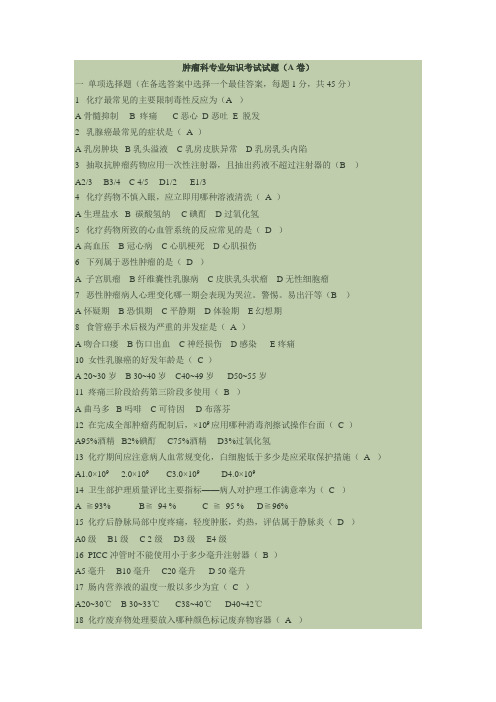
肿瘤科专业知识考试试题(A卷)一单项选择题(在备选答案中选择一个最佳答案,每题1分,共45分)1 化疗最常见的主要限制毒性反应为(A )A骨髓抑制 B 疼痛 C恶心 D恶吐E 脱发2 乳腺癌最常见的症状是( A )A乳房肿块 B乳头溢液 C乳房皮肤异常 D乳房乳头内陷3 抽取抗肿瘤药物应用一次性注射器,且抽出药液不超过注射器的(B )A2/3 B3/4 C 4/5 D1/2 E1/34 化疗药物不慎入眼,应立即用哪种溶液清洗( A )A生理盐水 B 碳酸氢纳 C碘酊 D过氧化氢5 化疗药物所致的心血管系统的反应常见的是(D )A高血压 B冠心病 C心肌梗死 D心肌损伤6 下列属于恶性肿瘤的是(D )A 子宫肌瘤 B纤维囊性乳腺病 C皮肤乳头状瘤 D无性细胞瘤7 恶性肿瘤病人心理变化哪一期会表现为哭泣。
警惕。
易出汗等(B )A怀疑期 B恐惧期 C平静期 D体验期 E幻想期8 食管癌手术后极为严重的并发症是(A )A吻合口瘘 B伤口出血 C神经损伤 D感染 E疼痛10 女性乳腺癌的好发年龄是( C )A 20~30岁B 30~40岁 C40~49岁 D50~55岁11 疼痛三阶段给药第三阶段多使用(B )A曲马多 B吗啡 C可待因 D布落芬12 在完成全部肿瘤药配制后,×109应用哪种消毒剂擦试操作台面( C )A95%酒精 B2%碘酊 C75%酒精 D3%过氧化氢13 化疗期间应注意病人血常规变化,白细胞低于多少是应采取保护措施(A )A1.0×109 2.0×109 C3.0×109 D4.0×10914 卫生部护理质量评比主要指标——病人对护理工作满意率为(C )A ≧93% B≧94 % C ≧95 % D≧96%15 化疗后静脉局部中度疼痛,轻度肿胀,灼热,评估属于静脉炎(D )A0级 B1级 C 2级 D3级 E4级16 PICC冲管时不能使用小于多少毫升注射器(B )A5毫升 B10毫升 C20毫升 D 50毫升17 肠内营养液的温度一般以多少为宜(C )A20~30℃ B 30~33℃ C38~40℃ D40~42℃18 化疗废弃物处理要放入哪种颜色标记废弃物容器(A )A红色 B黄色 C黑色 D白色19 重组粒细胞刺激因子最好在化疗后什么时候使用(B )A12小时 B24小时 C 36小时 D48小时20 化疗废物容器装满多少时不再使用( A )A2/3 B1/3 C3/4 D1/221 环磷酰胺不易溶于水需加热才能完全溶解但需小于多少度( D )A 30℃ B40℃ C50℃ D60℃22 卡培他滨应在餐后何时服用(B )A20分钟 B30分钟 C40分钟 D60分钟23 顺泊必须用何种溶液溶解(A )A生理盐水 B5%葡萄糖 C10%葡萄糖 D灭菌注射用水24 什么是肺癌病人首发症状(A )A咳嗽 B血痰 C胸痛 D发热25 用紫杉醇前口服地塞米松的时间为(A )A6小时 12小时 B4小时8小时 C2小时6小时 D半小时1小时26 疼痛按阶梯给药的顺序为( D )A可待因→吗啡针→阿司匹林 B吗啡针→阿司匹林→可待因C吗啡针→可待因→阿司匹林 D阿司匹林→ 可待因→→吗啡针27 配制化疗药物需戴几副手套( C )A不需要 B1副 C2副 D3副28 所有化疗废物需经多少度高温焚烧灭毒(D )A100℃ B200℃ C 500℃ D 1000℃29 换PICC贴膜时撕膜顺序为( D )A从内至外 B从外至内 C从上至下 D从下至上●30采用数字法评估疼痛时中度疼痛为几分(C )A1~3 B2~5 C4~6 D7~1031 乳腺癌常见而最早转移的淋巴结是(A)A同侧腋下淋巴结 B锁骨下淋巴结 C锁骨上淋巴结 D锁骨旁淋巴结 D对侧腋下淋巴结32胃癌好发的部位是(E)A贲门 B胃底 C胃体小弯侧 D胃体大弯侧 E胃窦33结肠癌最应重视的早期症状是(C)A腹痛 B贫血 C排便习惯改变 D粪便带脓血或粘液 E肿块34胃癌最主要的转移途径是(B)A直接蔓延 B淋巴转移 C血行转移 D腹腔内种植 E消化道转移35下列关于良性肿瘤特征的描述不正确的是(D)A边界清楚 B生长缓慢 C活动度好 D疼痛明显 E形状规则36国际TNM分期法中的M是指(C)A原发肿瘤 B肿瘤部位 C远处转移 D区域淋巴结 E肿瘤的恶性程度37下列有关于肿瘤化疗的护理叙述不正确的是(C)A药物必须现配先用 B药物不可溢出静脉外 C若出现药物外渗,应立即热敷 D每周检查白细胞和血小板计数 E用后的注射器和空药瓶单独处理38放疗病人口腔出现假膜时,应采用的漱口液为( B )A生理盐水 B双氧水 C甘草水 D金银花水 E呋喃西林液39患者李某,男,49岁,患胃癌晚期,病情日趋恶化,病人对医务人员工作不满,常常对陪伴家属发脾气,请问该病人的心理反应属于哪一阶段(B)A否认期 B愤怒期 C忧郁期 D协议期 E接收期40奥沙利铂在静脉治疗时出现渗漏,下面处理最不应该的是哪一项(B)A热敷 B 冷敷 C硫酸镁湿敷 D局部封闭 E喜辽妥外涂41长春新碱属于哪类抗肿瘤药物( D )A细胞毒素类 B抗代谢类 C抗肿抗生素类 D植物类42 PICC置管者封管注射器最佳选择是(C)A 2.5cm注射器B 5ml注射器C 10ml以上注射器D 以上都可以43原发性肝癌转移最早,最常见的是(A)A肝内血行转移 B淋巴转移 C种植转移 D外血行转移44抽吸化疗药物时,要注意抽出的药液不超过注射器容量的( D )A 1/2B 1/3C 2/3D 3/445诊断恶性肿瘤最可靠的依据是(C)A B型超声波B放射性核素检查C 病理检查 D X线造影46肺癌的恶性程度最高的是( B )A鳞状上皮细胞癌 B小细胞末分化癌 C大细胞未分化癌 D腺癌47早期肺癌的特征性症状是(B)A发热 B血丝痰 C哮鸣 D气促48以下哪项不是三阶梯癌痛治疗原则(B)A个体化给药 B按需给药 C口服给药 D按时给药49哪项不是上腔静脉压迫症状(A)A全身浮肿 B头面部及上肢浮肿 C颈静脉怒张 D口唇发青,呼吸困难51 甲状腺次全切除术中患者突然呼吸困难,失音,发绀应考虑(B)A 喉头水肿B 血管压迫气管C 两侧喉返神经损伤D 两侧喉返神经损伤与两侧喉上神经损伤E 两侧喉上神经损伤52对倾倒综合征的认识正确的是(A)A表现为进甜食后上腹部不适,心慌,恶心等B 可出现休克大出血C 长期不愈者可将毕式1式改为毕式2式手术D 为胃肠吻合过小而引起的 E 治疗应先禁食并给予胃肠减压,消炎等53结肠癌最应重视的早期症状是(C)A 腹痛B 贫血C 排便习惯改变D 粪便带脓血或黏液E 肿块54 急性肠梗阻的早期体征是(A)A 腹胀B 绞痛时伴肠鸣音亢进C 肠形蠕动波D 腹部包块E 腹膜刺激症55 能较早发现大肠癌术后复发的检查是(C)A 纤维结肠镜B 坝餐肠造影C 癌胚抗原检查D 直肠指检E 大便隐血实验●56乳房的正确检查方法(A)A 外上,外下,内下,内上、中央各区B 外上,外下,内上,内下中央各区C 中央,内下,内上,外上,外下D 外上,外下,内上,外上,外下E 内下,内上,外下,外上,中央各区57乳房肿瘤最常见的是(B)A 乳癌B 乳房纤维腺病C 乳管外乳头状瘤D 乳管内乳头状瘤E 乳房肉瘤58 胃癌最主要的转移途径是(B)A 直接蔓延B 淋巴转移C 血行转移D 腹腔内种植E 消化道转移60 患者女性,57岁,肺癌晚期行放射治疗,现皮肤高度充血,有水疱,局部有渗出液,该患者的皮肤状况以下说法正确的是(C)A 正常反应B 一度反应C 二度反应D 三度反应E 低蛋白水肿61 通过中心静脉途径进行胃肠外营养支持的病人,估计其接受营养支持的时间至少应为(C)A 3天B 1周C 2周D 3周E 4周62 对于门诊病人,判断甲状腺功能亢进病情程度最简单而主要的指标(B)A 突眼程度B 脉率和脉压C 体重减轻程度D 食欲亢进程度E 甲状腺肿大程度63女性,30岁,月经前乳房胀痛及出现肿块,月经后自行消退,应考虑为(C)A 乳腺癌B 乳腺肉瘤C 囊性增生病D 纤维腺瘤E 乳管内乳头状瘤64 下列关于良性肿瘤特征的描述不正确的是(D)A 边界清楚B 生长缓慢C 活动度好D 疼痛明显E 形状规则65 国际TNM分期法中的M是指(c)A 原发肿瘤B 肿瘤部位C 远处转移D 区域淋巴瘤E 肿瘤的恶性程度66下列有关肿瘤化疗的护理叙述不正确的是(C)A 药物必须新鲜配制B 药物不可溢出静脉外C 若出现药物外渗,应立即热敷,计数。
南开大学病理生理学2019年考博真题试卷

医学考博真题试卷
攻读博士学位研究生入学考试试卷
南开大学医学院
2019年攻读博士学位研究生入学考试试题
考试科目:病理生理学
注意:所有答案一律写在答题纸上,写在试题纸上或其他地方一律不给分。
一、名词解释
代谢性碱中毒
肝性脑病
低钾血症
二、简答题
1高钾血症酸碱代谢失衡的类型及心肌电生理特点
2MODS的组织和代谢变化
3肝纤维化的发病机制
4肺换气功能障碍的类型和机制
5全身缺氧的代偿和损伤变化
三、论述题
1休克器官功能障碍的细胞机制10分
2细胞功能ห้องสมุดไป่ตู้碍的方式,心血管疾病和肿瘤试述15分
3缺血再灌注钙超载的作用机制15分
4体液因素在损伤中的的作用方式简述,外泌体在衰老和肿瘤中的作用方式,机制15分
临床肿瘤学

试卷2新疆医科大学200——200—学年第()学期临床医学专业研究生期末(中)考试试卷(临床肿瘤学课程)姓名_______________________班级_______________________学号______________________考试时间:200年月日午______________ (北京时间)注意事项一、严守考场规则二、答题前请先在答题卡和答题纸上填写姓名、学号、班级。
注意字迹清楚,卷面整洁。
三、本试题由多选题和自由应答型试题组成。
四、试题与答题纸是分开的,答案必须标记或回答在答题纸上。
凡标记或回答在试题上的答案一律不计分。
五、请仔细阅读各型多选题的答题说明,严格按说明要求,用铅笔将答题纸上相应的英文字母圈出涂黑,如有变动,必须用橡皮将原先涂黑的地方擦净,再另选涂新的答案。
六、计分时只计答对的分数,答错的不扣分。
七、考试结束,请将试题和答题纸放在桌上,自行退场,试题和答题纸不得带出考场。
临床医学专业临床肿瘤学课程试题2一、选择题(每题 1分,共60分)1. 癌和肉瘤的根本区别是 A. 组织来源B•内在因素 C •外在环境D.形成方式E•大体类型2. 肝癌高发区的粮油食品以下哪种物质中含量较高5.肿瘤的异型性大,表示该肿瘤 A. 分化程度高,恶性程度高 B •分化程度高,恶性程度低C.分化程度低,恶性程度高| D •分化程度低,恶性程度低E .分化程度不一致,恶性程度可高可低A.食管镜取活组织检查B.定期食管钡餐C.反复食管拉网6.早期食管癌的病变范围是 A.限于粘膜层 B. D.其他器官转移E.侵入或侵透肌层 C.远处淋巴结转移病变长度超过5cm3个月,钡餐检查示食管上段有7 cm 长不规则充手术治疗7•患者女性,60岁,进行性吞咽困难15.动脉化疗栓塞应用最多最广的疾病是19. 男,48岁,因胃癌而行剖腹探查时,发现肿块已浸润至横结肠,但较局限,该病人宜A .禁忌手术 B.行胃癌根治术+横结肠切除术 C .行胃大部切除术D.行全胃切除术E .行横结肠切除术20. 直肠癌出现症状频率依次为 A. 便频、粘液便、里急后重 B .粘液便、便血、里急后重 C.粘液便、里急后重、便细 D .便频、里急后重、粘液便E. 以上都不对21. 关于子宫颈原位癌,正确的是D.开腹探查E.纵隔镜检查11. 肿瘤放射治疗时使用的放射性核素所产生的射线最常用的是 A. X 射线 B. 质子束 C.D. 丫射线E.电子束12. 为提高放疗的疗效,可采用下列哪项措施 A.加化疗B.加热疗C.D.应用放射增敏剂E.以上都对13. 下列哪项检查是确诊鼻咽癌的最佳手段 a 射线纠正贫血A .鼻咽部CTB D. EB 病毒血清学检查E.14.最常用的动脉穿刺插管途径是 A .肘动脉B D.颈总动脉 E .鼻咽部核磁共振.足背动脉 .鼻咽部侧位片.锁骨下动脉A.肺癌 B .直肠癌 .肝癌D.子宫颈癌E.胃癌16. 胃癌最常以下列哪种方式发生转移 A .血行移植 B .淋巴转移 D.腹腔种植E.以上都不是17. 结肠癌最常见的大体病理类型是 A .肿块型 B .浸润型 D.弥散型E.以上均不是 .直接蔓延.溃疡型18.对一名50岁的便血男性病人,A .直肠镜检查 B门诊检查中首先考虑的是 .直肠指检C.肛门镜检查D.纤维结肠镜检查E .腹部B 超A. 病变局限于宫颈,无淋巴结转移B. 病变局限于宫颈上皮层内,且无间质浸润C. 可借宫颈细胞学检查及阴道镜与浸润癌鉴别23•对放射治疗高度敏感的卵巢肿瘤是24. 关于卵巢恶性肿瘤的手术治疗原则,下列哪项是正确的A. 低潜在恶性肿瘤,临床la 期,年轻未生育,可仅作患侧附件切除,术后定期随访 是否行全子宫及双侧附件切除术,应根据病人的年龄来决定25. 在下列抗肿瘤药物中,属于烷化剂的是 A. 甲氨蝶呤 B.顺铂 C .卡铂D.环磷酰胺E •长春新碱26. 下列哪项措施可预防急淋白血病或非霍奇金淋巴瘤中枢神经系统的侵犯 A.鞘内注射甲氨蝶呤 B. 静点甲氨蝶呤C.鞘内注射亚叶酸钙D. 静点亚叶酸钙E. 鞘内注射阿霉素27. IV 期霍奇金淋巴瘤的治疗首选C.急性传染性单核细胞增多症D. 镜下表现为中度不典型增生E. 应行广泛性子宫切除术22. 33岁,因接触性出血就诊,查宫颈中度糜烂,液基薄层细胞学检查示ASCUS 非典型鳞状上皮细胞),进一步检查为 A.严密观察随访 B. 阴道镜下活检 C.再次宫颈涂片D.分段诊刮术E. 碘试验A.内胚窦瘤B. 浆液性囊腺瘤C.粘液性囊腺瘤D.无性细胞瘤E.纤维瘤B.C. 肿瘤包膜破裂,不应施行大网膜切除D. 必须行盆腔淋巴结清除术E. 较晚期者手术加用放疗疗效最佳A .手术治疗D.化疗+放疗.化疗 C.手术+放疗.放疗28. 下列哪项目前仍是发现、诊断肺癌和提供治疗参考的重要基本方法 A . X 射线检查B. CT检查 CD. PET 和PET/CT 检查 E .痰细胞学检查MRI 检查29. 下列哪种疾病能找到 R-S 细胞B.非霍奇金淋巴瘤霍奇金病35. 乳癌侵犯乳房悬韧带(coopier 韧带) 引起相应的体征是 A .橘皮样改变 B .乳头改变 CD.局部水肿 E•铠甲状胸壁36.男性35岁右侧甲状腺单发结节 3X 2cm,术中病理报告为甲状腺乳头状癌,最合 适的进一步处理是A.缝合切口,结束手术B. 术后放射性碘治疗C. 化学药物治疗E. 双侧全切加颈淋巴廓清术37. 患者女性65岁 洗澡时发现右乳外上近乳头处有一肿物,既往体健,查体:右乳 外上象限近乳晕处 2X 1.5cm 质硬肿物,肿物局部皮肤稍凹陷,无压痛,边界尚清,腋 窝未触及明显重大的淋巴结,穿刺后病理证实为侵润性导管,目前最恰当的术式是A.乳房单纯切除术B. 肿块局部切除术C. 乳腺癌根治术D.乳腺区段切术加腋窝淋巴结清扫术 D.结缔组织病 E.恶性肿瘤30. 男性,30岁。
- 1、下载文档前请自行甄别文档内容的完整性,平台不提供额外的编辑、内容补充、找答案等附加服务。
- 2、"仅部分预览"的文档,不可在线预览部分如存在完整性等问题,可反馈申请退款(可完整预览的文档不适用该条件!)。
- 3、如文档侵犯您的权益,请联系客服反馈,我们会尽快为您处理(人工客服工作时间:9:00-18:30)。
3 3a期NSCLC治疗方案是什么?
4女性45岁右侧乳腺外上象限3cm肿瘤经改良根治术后病理确定为浸润性导管癌脉管内可见癌栓腋窝淋巴结4/10转移ER+ PR+ HER2-未发现远处转移问治疗方案是什么?
5男性50岁鼻咽未分化非角化癌位于左侧鼻咽累及同侧咽旁间隙头长肌颅底斜坡骨质颅神经未受累双颈部IIB及III区多个肿大淋巴结最大2.5cm基线查体未发现转移问临床分期及相应治疗方案?
二简答题
1乳腺癌术前新辅助治疗的合适人群有哪些?
2放射生物学的4R包括哪些?
3 DNA修复机制有哪些?
4直肠癌新辅助治疗的目的是什么?
5肿瘤遗传易感性是什么意思?
6细胞癌变的分子机制有哪些?
7放射线杀死恶性肿瘤细胞原理有哪些?
8乳腺癌的保乳术后部分乳腺加速照射技术是什么?
三论述题
1 HER2阳性的复发转移乳腺癌的治疗策略及相关研究进展是什么?
南开大学
医学考博真题试卷
攻读博士学位研究生入学考试试卷
南开大学医学院
2019年攻读博士学位研究生入学考试试题
考试科目:临床肿瘤学
注意:所有答案一律写在答题纸上,写在试题纸上或其他地方一律不给分。
一名词解释
1 PCD 2乳腺癌前哨淋巴结3细胞增殖周期4肿瘤微环境5 Cyclin蛋白
6 Heterogencity 7肿瘤标志物8肿瘤分子流行病学9副肿瘤综合征10 GTV CTV PTV
